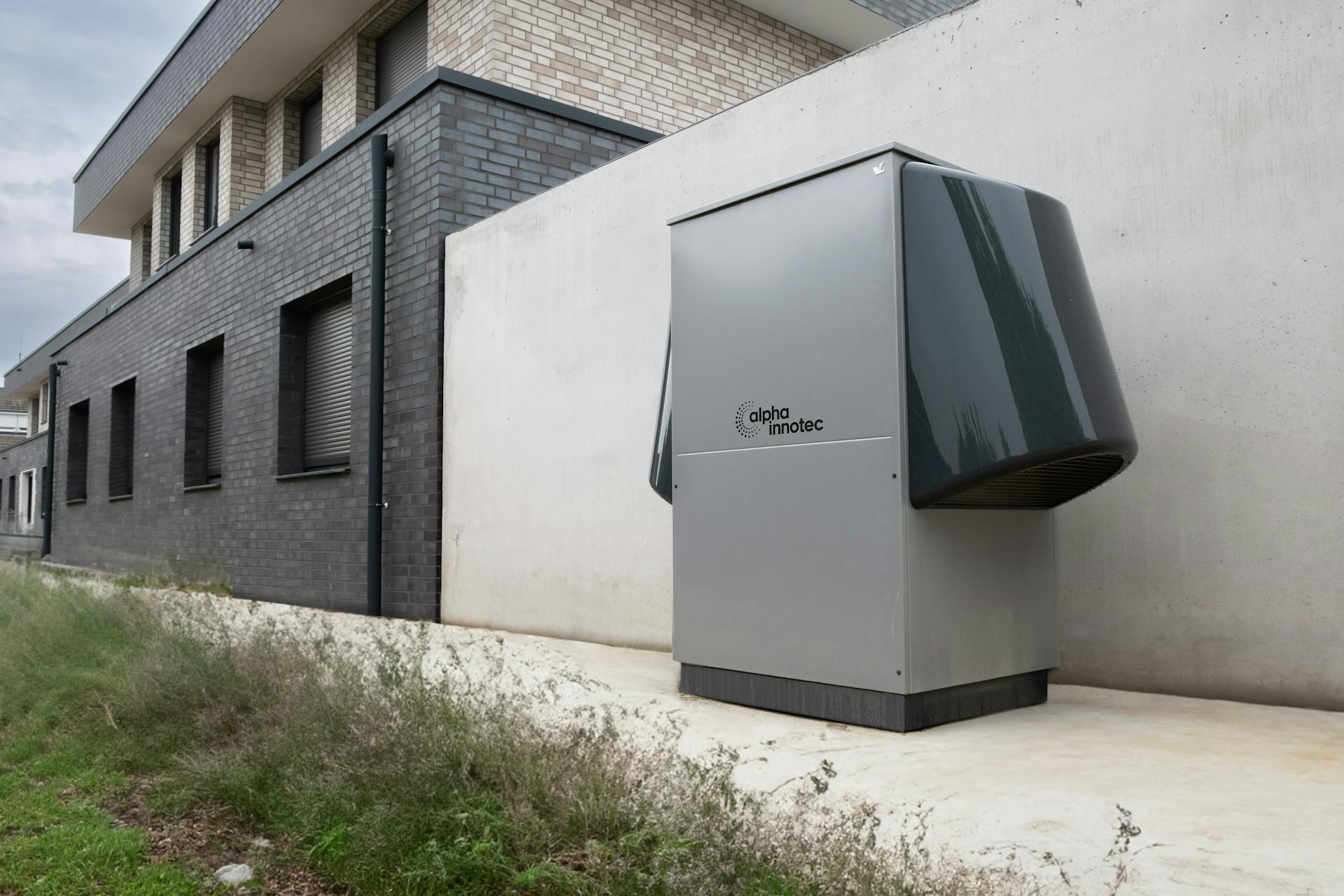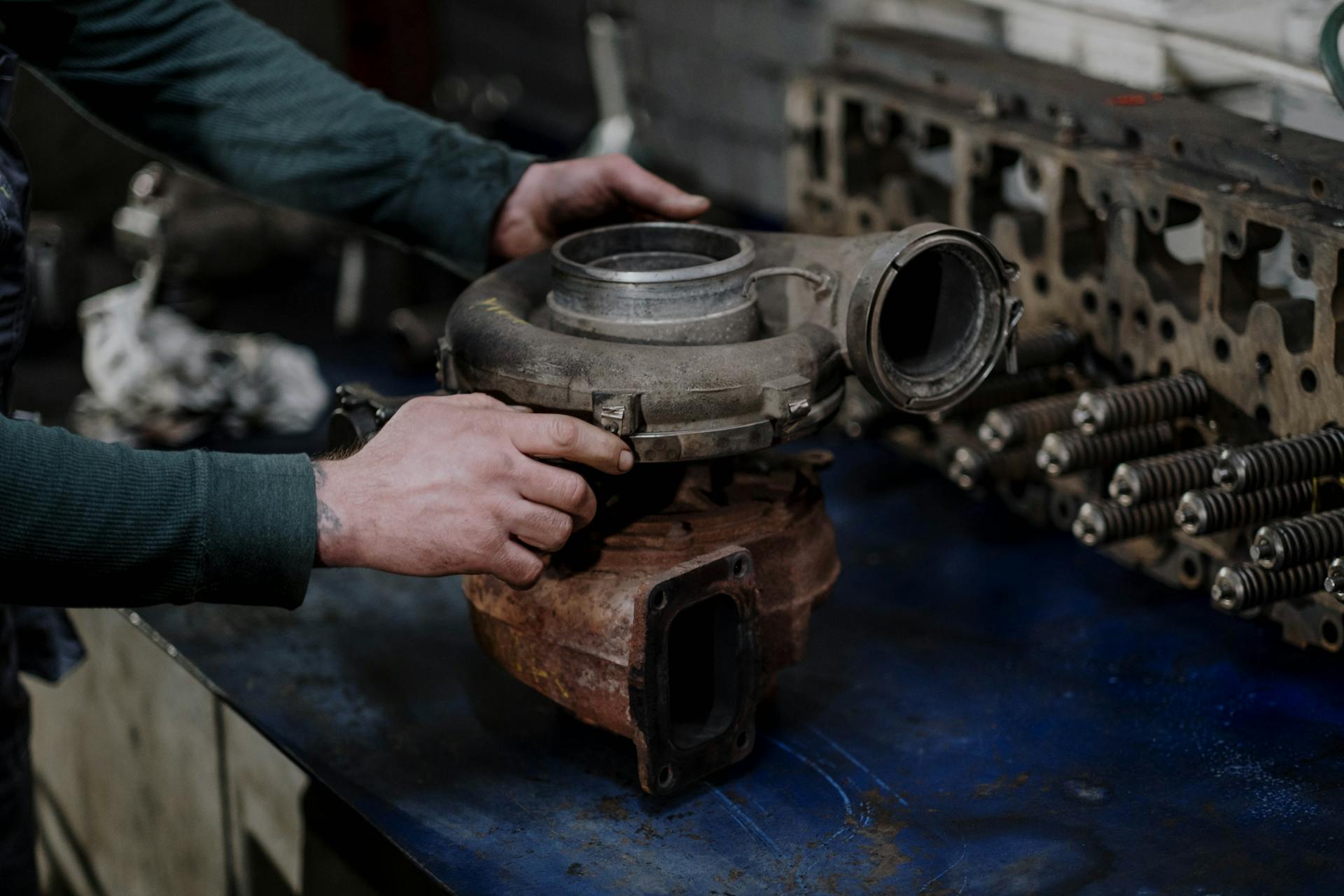
A thermoelectric generator is essentially a device that converts heat into electricity, making it a promising technology for harnessing waste heat.
The efficiency of a thermoelectric generator is a crucial factor in determining its overall performance.
At its core, a thermoelectric generator relies on the Seebeck effect, where a temperature difference is used to generate an electric current.
However, the efficiency of this process is limited by the materials used in the generator.
Types of Generators
Thermoelectric generators vary significantly in geometry, depending on the type of heat source and heat sink, the power requirement, and the intended use.
Some generators were used to power portable communications transmitters during World War II.
Improvements in semiconductor materials and electrical contacts between 1955 and 1965 expanded the practical range of application.
Many units require a power conditioner to convert the generator output to a usable voltage.
Principle and Mechanism
The principle of thermoelectric generators is based on the direct conversion of heat into electricity, which is a fundamental concept in thermoelectricity. This is made possible by the Seebeck Effect, where a voltage develops between the junctions of two dissimilar metals at different temperatures.
The Seebeck Effect produces measurable amounts of voltage and current, and the current density generated by a thermoelectric generator can be calculated using the Seebeck coefficient and the temperature gradient. The Seebeck coefficient is inherently unique to each material being used.
Thermoelectric generators are solid state heat engines made of two primary junctions, the p-type and n-type elements, which are doped to have a high concentration of positive and negative charge respectively. The p-type elements have a positive Seebeck coefficient, while the n-type elements have a negative Seebeck coefficient.
When an electrical connection occurs between the p-type element and the n-type element, for every hole that migrates to the n-type material, an electron from the n-type moves to the p-type material. This process helps to describe the heat dissipation or absorption at the connection of the conducting materials, which is known as the Peltier Effect.
The Peltier Effect plays a crucial role in understanding the thermoelectric effect, and it's essential to consider it when designing and optimizing thermoelectric generators.
Additional reading: Peltier Effect Generator
Materials and Efficiency
Thermoelectric materials are a crucial aspect of thermoelectric generators. Two important thermoelectric materials are Bismuth Telluride (Bi 2Te 3) and Lead Telluride (PbTe), which have a figure of merit of 1 at specific temperatures.
The figure of merit is a metric that helps evaluate the thermoelectric properties of a material. To be a viable source of power, the figure of merit must be 2 to 3.
A wide temperature gradient is also essential for thermoelectric materials, as it reduces heat-induced stress and potential material fracture. The mechanical properties of the materials and the coefficient of thermal expansion of n-type and p-type materials must be matched reasonably well.
The efficiency of current thermoelectric generators is around 5-8%, with older devices even less efficient due to the use of bimetallic junctions. Modern devices use doped semiconductor materials like Lead Telluride (PbTe), Bismuth Telluride (Bi 2Te 3), and Calcium Manganese Oxide, or combinations of these materials.
You might enjoy: 3 Phase Ac Generator
Fossil-Fuel Generators
Fossil-fuel generators are a common choice for remote areas, and they're surprisingly versatile. They can run on a variety of fuels, including natural gas, propane, butane, kerosene, and even jet fuels.
Generators in this category are typically small, with output power ranging from 10 to 100 watts. This makes them perfect for applications like navigational aids and data collection systems.
One notable use of fossil-fuel generators is in cathodic protection systems, which prevent electrolysis from corroding metallic pipelines and marine structures.
Solar Source
Solar Source is a promising area of research in the field of materials and efficiency. Solar thermoelectric generators have been used to power small irrigation pumps in remote areas.
These generators use warm surface ocean water as the heat source and cooler deep ocean water as the heat sink. This system has been described in experimental settings.
Solar thermoelectric generators have also been designed to supply electric power in orbiting spacecraft. However, they haven't been able to compete with silicon solar cells, which have better efficiency and lower unit weight.
But there's still potential for solar heat to be used in spacecraft, particularly for thermal control. Thermoelectric devices can generate electrical power using solar heat from the Sun-oriented side of the spacecraft.
Curious to learn more? Check out: Portable Solar Generators for Home
13.0 Power Generation
Power Generation is a critical aspect of many applications, and nuclear-fueled generators offer a reliable solution. They utilize the decay products of radioactive isotopes to provide a high-temperature heat source for thermoelectric generators.
Thermoelectric devices are surprisingly resistant to nuclear radiation, making them ideal for use in these generators. This property allows them to provide power for long periods of time.
Radioisotope thermoelectric generators have been used to power isolated weather monitoring stations, deep-ocean data collection, and various warning and communications systems. They've even been used in spacecraft.
A low-power radioisotope thermoelectric generator was developed as early as 1970 and used to power cardiac pacemakers. This technology has been around for decades.
The power range of radioisotope thermoelectric generators is generally between 10 and 100 watts. This makes them suitable for a wide range of applications.
Readers also liked: Stirling Radioisotope Generator
Materials
Materials play a crucial role in determining the efficiency of thermoelectric generators. Two important thermoelectric materials are Bismuth Telluride (Bi2Te3) and Lead Telluride (PbTe).
Bismuth Telluride (Bi2Te3) is effective at room temperature, acting as the cold side, while Lead Telluride (PbTe) is effective at 500K to 600K, acting as the hot side. The figure of merit for both materials is one at their respective temperatures.
To be a viable source of credible power, the figure of merit must be 2 to 3. This is a key factor in selecting the right thermoelectric material.
A wide temperature gradient is also essential in thermoelectric materials. If the gradient is not wide enough, the material will be susceptible to heat-induced stress, which can lead to its fracture.
The mechanical properties of the materials must also be considered, and the coefficient of thermal expansion of the n-type and p-type materials must be matched reasonably well.
Thermoelectricity Basics
A thermoelectric device is essentially a solid-state heat engine that converts waste heat into electricity.
These devices rely on the movement of charge carriers, such as electrons in N-type materials and holes in P-type materials, which flow freely through metals and semiconductors.
In the presence of a temperature gradient, charge carriers diffuse from hot to cold, resulting in the buildup of charge carriers known as the Seebeck effect.
The efficiency of a thermoelectric device is closely related to the semiconductor's material properties.
To be competitive with current power generation methods, a thermoelectric device must possess a figure of merit, ZT, greater than 3.
Unfortunately, over the past five decades, the room temperature ZT of materials with our best available technology has only slightly increased from 0.6 to about 1.0.
Here are some key properties that affect the efficiency of a thermoelectric device:
The best performing materials to optimize ZT tend to be heavily doped semiconductors, but simply increasing the electrical conductivity simultaneously decreases the Seebeck coefficient and increases the thermal conductivity.
Market and Applications
Thermoelectric generator efficiency has a wide range of applications, from powering small devices to generating electricity for entire communities.
The efficiency of thermoelectric generators can be improved by optimizing the design of the thermoelectric materials, such as using nanotechnology to increase the power factor.
Thermoelectric generators can be used to harness waste heat from industrial processes, such as in the cement industry, where they can generate up to 1.5 kW of electricity per ton of cement produced.
The efficiency of thermoelectric generators can also be improved by using advanced materials, such as bismuth telluride, which has a high power factor and can be used to generate electricity from low-temperature heat sources.
Thermoelectric generators are being used in a variety of applications, including remote power generation, space exploration, and even in some consumer products, such as portable power sources for electronic devices.
Frequently Asked Questions
How much electricity can a thermoelectric generator produce?
A thermoelectric generator can produce electricity ranging from 1 to 125 watts, and up to 5 kilowatts when connected in a modular system.
What is the main disadvantage of thermoelectric electricity generators?
The main disadvantage of thermoelectric generators is their low energy conversion efficiency rate, which limits their overall effectiveness. This is due in part to their need for a relatively constant heat source.
How efficient are Seebeck generators?
Seebeck generators, also known as TEGs, have an efficiency range of 5-8%. Their efficiency can be higher in specific applications.
Featured Images: pexels.com


